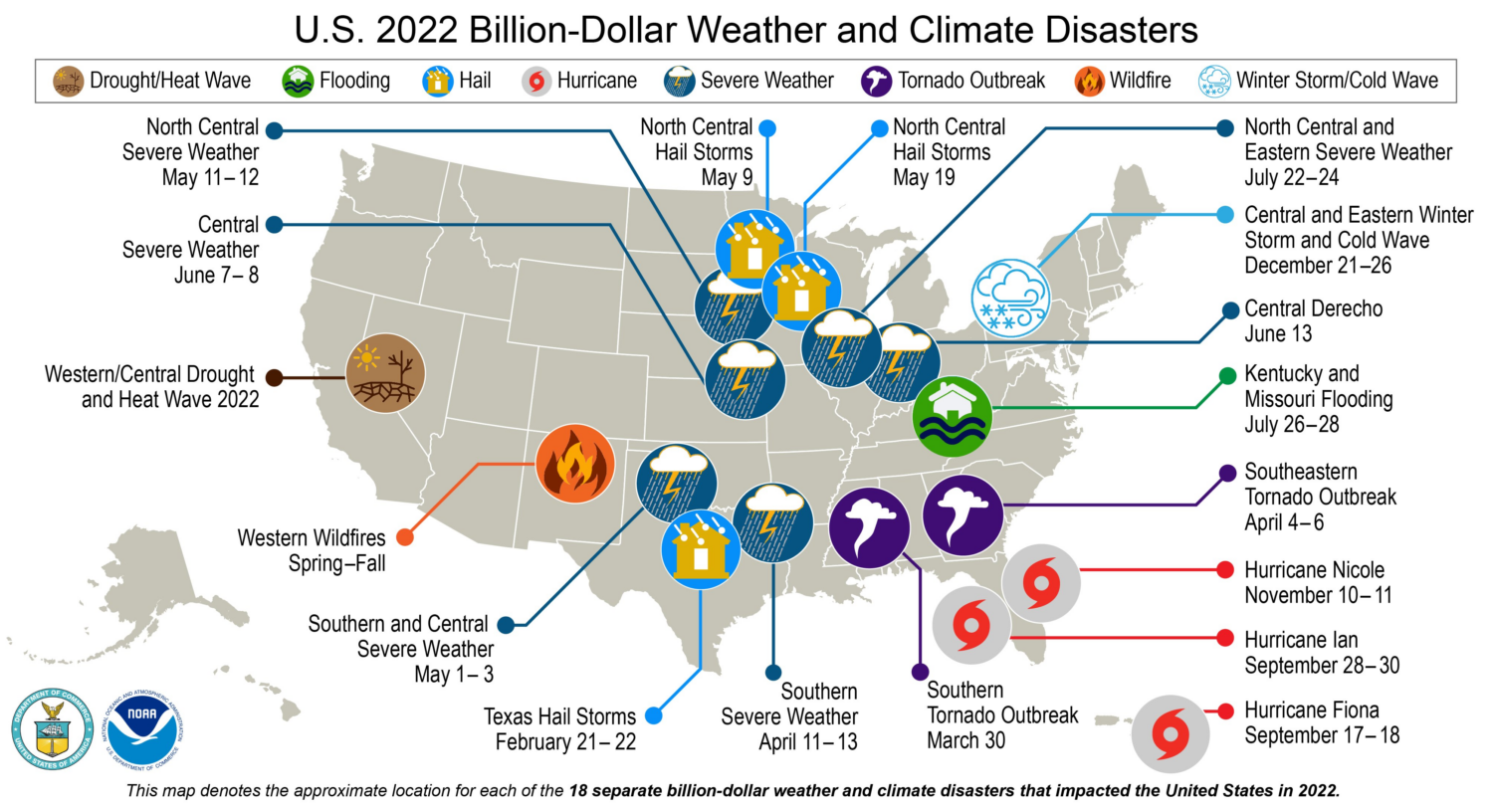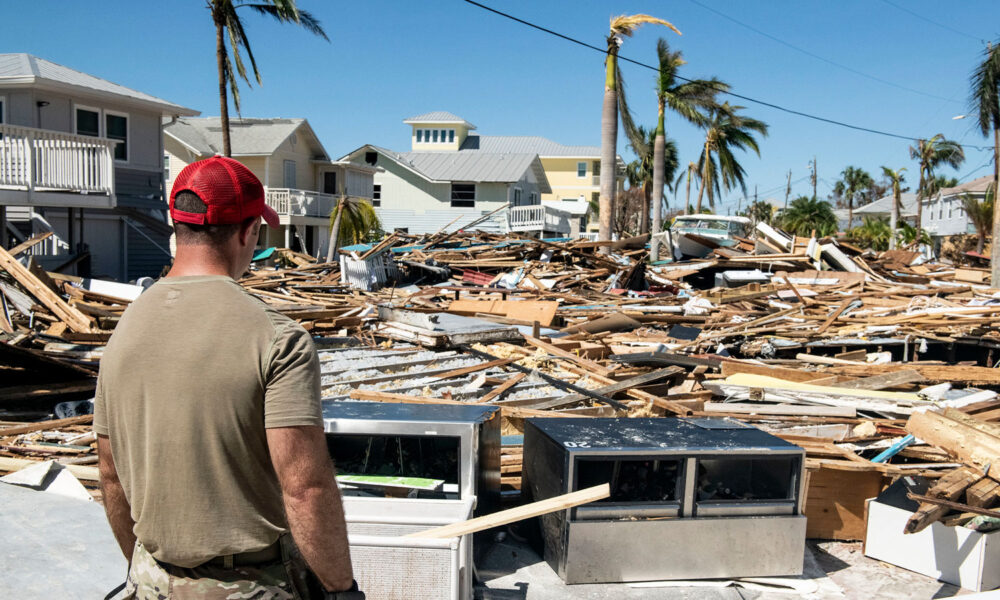Today the National Oceanic and Atmospheric Administration (NOAA) released its annual report on billion-dollar weather and climate-related disasters in the United States, which tells a grimly familiar story.
In 2022, the nation experienced 18 disasters with costs exceeding a billion dollars each, and together these disasters caused at least 474 deaths. Together these disasters cost at least $165 billion, making 2022 the third most costly year on record. Many of these disasters—including floods, storms, wildfires and droughts—were worsened by climate change.

Around the world, too, the toll was staggering, from devastating floods in Pakistan and China to the catastrophic ongoing drought in the Horn of Africa and record-breaking heatwaves in India, Pakistan and Europe. Climate change is not the sole causative factor, of course. Maladaptive development patterns, racism and unjust socioeconomic factors are also responsible for putting more people and property in harm’s way.
But the science is clear: human-caused global warming is definitely and significantly increasing the odds of severe and once-rare extreme events, alongside driving slow-onset disasters—like sea level rise and the loss of major ice sheets and glaciers—and raising the risk of major tipping points.
Wherever you live in the United States, you were undoubtedly affected by these disasters, directly or indirectly.
The worst time of the year—which we at UCS named Danger Season—brought a parade of flood warnings, extended heatwave advisories, wildfire smoke alerts, hurricane evacuation orders, drought declarations, and power outages that seemed endless and ubiquitous. Even if you and your community were lucky enough to be spared, someone you know and love probably wasn’t.
The farms that grow the food you eat or raise the cattle that provide you meat and dairy, from the Midwest to Texas and California, were affected by floods and/or droughts. The water levels in the mighty Mississippi River, along which barges that carry so much of our nation’s goods travel, reached historic lows. Critical infrastructure we depend on—from power grids to roads and bridges—was battered by storms or buckled under the pressure of weather extremes.
All of that added up to an incredible burden to the economy, and the $165 billion in costs for 2022 NOAA estimated is very likely an undercount of the true cost. It only includes the economic costs of major disasters and primarily focuses on those that are easily quantified.
How do you measure the public health burden on young children whose tiny lungs inhaled the equivalent of a pack of cigarettes because of smoke from wildfires? How do you measure the loss of community and cultural heritage when precious places flood or burn? How do you count the cost of lives needlessly lost? How do you put a price to the loss of habitat and threats to animals and plants, both terrestrial and aquatic?
The rising costs and human toll from climate impacts, as well as from our longstanding dependence on fossil fuels, make clear that doing nothing is the most expensive and harmful choice we can make. Smart investments in clean energy and climate resilience, done in an equitable way, can help limit the costs of runaway climate change while also advancing a fairer, healthier society.
That’s why the long-waited climate bill that the U.S. Congress finally passed last year—the Inflation Reduction Act—is so important. It will help make a serious dent in reducing our heat-trapping emissions, not nearly enough to meet what the science shows is necessary but nevertheless a reason for hope.
Now it’s time to make sure this law is implemented in as robust a way as possible to benefit all, especially those who have long been marginalized and left behind. And, in this decisive decade for climate action, we must push policymakers to do a lot more—to cut emissions more sharply, to invest adequately and proactively in climate resilience, and to act in solidarity with the global community to address climate change.
It’s heartbreaking to take stock of the terrible year 2022 was for people in the United States and around the world, part of a trend of mounting losses and damages from climate change now colliding with other ongoing challenges like the global economic crisis, the COVID-19 pandemic, and the fallout from the war in Ukraine.
At COP27, the annual UN climate talks that took place in Egypt last November, we heard from 10-year-old Nakeeyat Dramani Sam of Ghana, a nation that has recently experienced devastating floods, who called on policymakers to ‘Have a heart, and do the math. It’s an emergency!’ (You can watch her powerful speech here).
Indeed, the math is unrelentingly clear. The math of rising carbon emissions and the rapidly dwindling carbon budget to stay below 1.5˚C. The math of fossil fuel companies’ obscene profits even as working people struggle to pay energy bills. The math of a divided U.S. Congress, with many who refuse to acknowledge the climate crisis or address it with the urgency it requires. The math of the many millions of people on the frontlines of the burgeoning climate crisis.
Can we find it in our hearts to do better for young people, whose futures hang in the balance? For our planet and all its precious flora and fauna, which are also at stake? Or will we continue to see growing lists of increasingly catastrophic climate-fueled disasters year after year?
The choice is ours—and the responsibility right now is squarely on policy makers.

